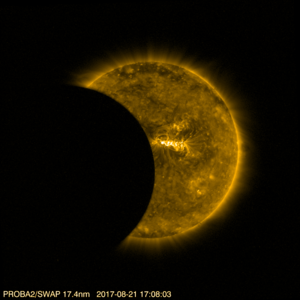
Proba-2 views four partial eclipses
ESA's Proba-2 satellite observed four partial eclipses while observers in parts of South America witnessed a total solar eclipse on 2 July.
A solar eclipse occurs when the Moon passes between Earth and the Sun, totally or partially blocking the Sun from Earth’s point of view. From Proba-2's perspective in Earth orbit the Moon crossed the satellite’s field of view four times.
The video was produced from images taken by Proba-2’s SWAP imager, which images the Sun in ultraviolet light revealing the turbulent nature of the Sun's surface and corona – the Sun's extended atmosphere – stretching into space.
During this eclipse the satellite was passing through the South Atlantic Anomaly at the time of the largest occultation. In this region the spacecraft is exposed to higher levels of radiation. The increased flux of energetic particles falling on the satellite's detector is the cause for all the bright dots and streaks in the images.






